|
The PT-109 kit. This kit can trace its lineage to the early 1960s. Let’s start with the 1963 original version of this kit. This version had an excellent box-art painting by the famous John Steel, which was suitable for framing. That painting, in my opinion is one of the best paintings concerning PT boats ever done.
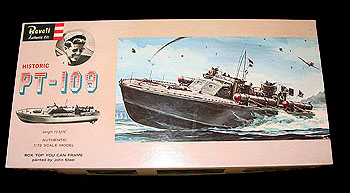
The kit was molded in a shade of green which was only slightly lighter than the green which was used for the 1977 version of the kit. The sprue trees, seen here, included some of the following items:
The four steel torpedo tubes
The two twin .50 caliber machine guns
The single 20mm Oerlikon AA gun
Three full bodied crew figures (one of which represents John F. Kennedy as a Lieutenant (junior grade) and a half-bodied crew figure (to represent a machine-gunner for one of the two turrets) with positionable arms
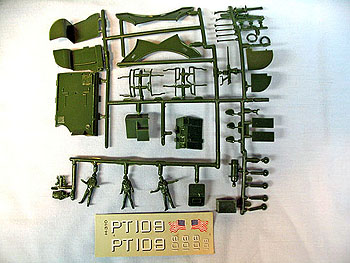
Here is another photo of more of the sprue-trees from the 1963 version. In it, the three steel propeller shafts can be seen. These steel shafts were unfortunately phrased-out of the kit in 1965 and replaced by the now standard plastic ones. Personally, I think this is a shame as they, I feel, add a little more ‘realism’ to the model’s appearance. Hopefully, if Revell ever decides to‘re-tool’ this fine little kit, they will bring the steel propeller shafts back in the kit.
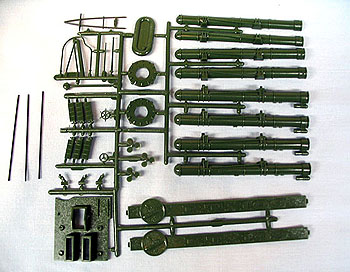
Here is the deck and the hull of the 1963 vintage edition of the PT-109 kit.
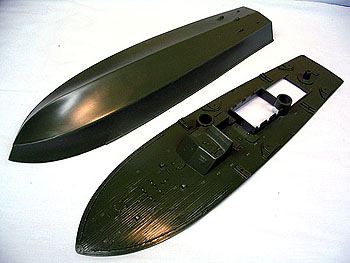
Overall, the level of detail in this kit is, considering the time in which it was first produced, is impressive. Although, the engraving of the planking of the deck is done too heavily (but, by the same token, one has to keep in mind the technology of the time). Now-a-days, modelers tend to sand the deck planking down to a more ‘acceptable’ level.
There is something about the deck piece of this kit that I had not noticed until I looked at the photos provided by Mr. Traxel. This is that Revell engraved the dead-lights into the decks. That is impressive. Well, at least impressive to me.
There are a few things about this kit that as a small boy never really bothered me, well because, as a boy, I did not know any better. However, as both as an adult and a naval historian who specializes in PT boats and as someone who likes to have historically accurate and well-detailed models built for me, I have found that these few things actually do bother me.
The first thing which bothers me is the attention that Revell paid to the 20mm Oerlikon gun as opposed to how they produced the two twin .50 caliber machine guns. The 20mm gun by itself (even by today’s standards) is ‘good enough’ to be used, if a modeler so chooses. However, the two twin .50 caliber machine guns lack even the most basic level of detail. I cannot understand how Revell could do such a ‘good job’ (for the time) on the 20mm and not on the machine guns. Technology of the day? Perhaps. But, how does that explain the ‘good job’ on the Oerlikon gun?
Another item in this kit is Revell’s rendition of the Balsa-wood Carley-float. If one takes just a cursory look at the item, it would give one the impression of being a yellow rubber inflatable life-raft and not a Balsa-wood Carley-float. In fact, if one takes a look at the box-art for the PT-167 incarnation of this kit; one will actually see that the raft which is located on the fore-deck is colored yellow.
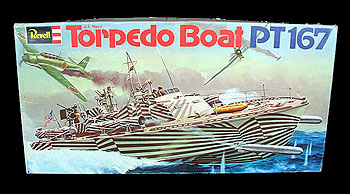
If a ship-modeler who does not know the ‘ins-and-outs’ of PT boats is building the Revell kit and just happens to see the box-art for the kit of PT-167, that modeler is going to think (and assume) that the raft is of the rubber inflatable type and not a Balsa-wood Carley-float. To think about it logically; why would a crew have an inflatable life-raft on deck, in the open where it could be holed by gunfire.
In fact, recently, a modeler emailed me a few ‘in-progress shots of a Revell PT boat which he was building and detailing and inquired on what I thought of his progress. Not wanting to either hurt his feelings or malign his efforts (because I despise it when ‘experts’ do that), I innocently asked him why he had painted the raft a faded yellowish color. He replied that it was how a rubber-raft would appear if it was, to quote him, ‘rode hard and put away wet.’
That said; if one would look at the box-art of the 1963 version and the box-art of the PT-190 kit and the box-art of the PT-190 kit (both of which were, more-or-less ‘concurrent’ releases)
|
|
PT-109 Kit Box |
PT-167 Kit Box |
one will see that the rafts were painted the same color of the boats, leading me to believe that someone at Revell did enough back-ground research on the two subjects to realize that the rafts were probably made of a material that required painting and not made from rubber. In the case of Mr. Steel’s painting; it would appear, at least to me that he knew PT boats carried Carley-floats.
Then, why does the raft in the PT-109 (as well as its subsequent derivatives) look like an inflatable rubber raft? I cannot answer that. However, if one looks at the raft which is supplied in the Revell Vosper MTB kit (which was more-or-less a ‘concurrent’ release of the PT-190 and PT-167 kits) actually looks more like a Carley-float. Why Revell could not put that raft into either of those two kits as well as the later releases of the PT-109 is puzzling to me.
The Carley-floats were supposed to look like this, as shown the photo shown. This photo is of the Carley-float that a modeler put onto a model of PT-556 that was created by using the mid-1960s era version of the PT-109 kit. Compare this one to the unmodified and undetailed one that comes with the 1977 kit.
|
|
Mid-60s version |
1977 Kit Version |
Just by making a cursory look at the kit-provided one, one can see how a modeler would mistake this item for an inflatable rubber lift-raft rather than a Balsa-wood Carley-float. In order to get the appearance of the Carley-float that is on my model of PT-556, what a modeler needs to do is cut away the bottom of the kit’s raft, and use masking tape as the canvas webbing and a wooden dowel for the water cask and the White Ensign Models photo-etched details for the raft that are included in the photo-etched brass fret made for the kit.
Revell did miss a few details, especially on the charthouse structure. Things like ports and vents and navigation lights. Almost fifty years later, this ‘mistake’ was corrected by the White Ensign Models’ Photo-etched detail set which was designed by White Ensign’s Peter “Mad Pete” Hall expressly for this kit.
Seen here is a 1977 release vintage version of the PT-109 kit. It differed from the original 1960s era kit by having plastic propeller shafts rather than the brass-rod ones. Another difference is the obvious change in box-art. Included in this version is an offer to join the Revell Modelers’ Club and a way to get a free modeling tool kit.
The model itself was molded in a dark green plastic. Other than having plastic propeller shafts, it is the same kit as the original 1963 version.
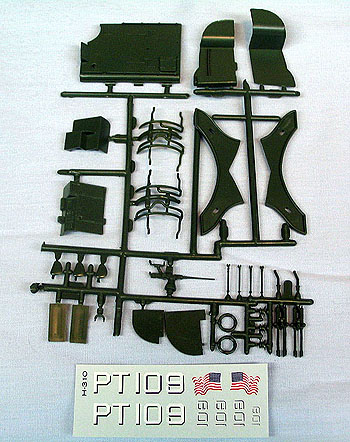
The PT-190 Incarnation
|